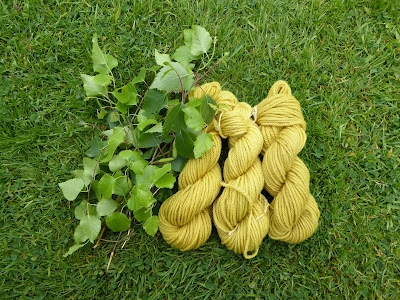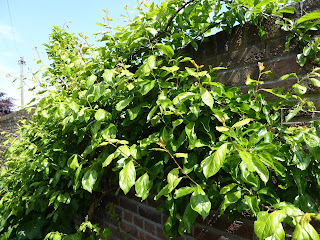Not long ago, I accidentally mordanted some Shetland wool yarn using 20% of the weight of the wool in alum crystals, instead of my usual 10%. I thought the amount of colour the yarn picked up from a dye bath of birch tree leaves looked far more impressive than the colour on a smaller skein of the same yarn that had been dyed in the same bath after being mordanted with 10% alum.
Over a cup of tea in the garden, my companion, Elinor Gotland, quite agreed.
"The little skein looks crap compared to the big one with more mordant. Looks like you've been spoiling the ship for a ha'porth of tar, Beaut. Speaking of ha'porths, how much does alum actually cost?"
"Well, very little actually. I paid about £12 for a kilogram, so even if I didn't reuse the solution, the difference between using 10g or 20g of alum to mordant 100g of wool would be 12 pence. I'm not so fussed about the money, so much as the environmental cost of using more."
"Oh, for heaven's sake, aluminium is the most abundant metal on earth and you're always harping on about how you exhaust your mordant solutions by reusing them three times. Do yourself a favour and get the best out of those plant dye baths you spend half your life brewing up. Making mouldy colours is a waste of all the natural gas you burn, simmering dye pots for hours on end."
"Hmmm. Maybe you've got a point, Elinor. I've read older dye recipes where higher percentages of alum seem to have been standard practice. Along with Glauber's Salts and a whole range of other stuff you don't see in the chemists' anymore. Perhaps the old girls had the right idea all along."
My accidental 20% alum mordant bath included some 50g skeins of Drops Alaska aran wool yarn. I mordanted a couple more skeins with 15% alum and 10% alum and then collected another 150g birch tree leaves while out walking the dog. After simmering the leaves for an hour, I added an equal weight of yarn and half a teaspoon of soda ash to bring the pH just above neutral, simmered the wool in the pot for an hour and left it to soak overnight.
Once the yarn had dried, there wasn't much difference between the three skeins. They were all more yellow and less green than the previous birch leaf dye, which may be because the leaves are no longer so very newly grown. The skeins were tagged, so I knew the one on the left of this picture was mordanted with 10% alum and could see it was only very marginally yellower in tone and slightly paler than the one on the right, which had been mordanted with 20% alum. This made it clear that I hadn't managed to replicate the conditions which produced the contrast between the original 20% versus 10% mordanted skeins. Above and beyond that, it made no sense to me that the skein in the middle, which had been mordanted with 15% alum, looked paler than either of the others.
Obviously, first thing to do was to repeat the test. No flowers are anywhere near blooming in the dye garden, but the plum trees espaliered against the wall needed their tips soft pruned this week. I used to get yellow dyes from the leaves of the apple trees that grew there before, so this seemed a good opportunity to test the dye potential of my plum tree leaves as well as repeating the alum mordant assessment.
150g fresh plum tree leaves were simmered in water for an hour. They released no perceptible colour into the dye bath and its pH tested as mildly acidic. I put three skeins of yarn into the clear fluid, although I only had 25g mordanted with 10% alum, and simmered them for an hour. Next morning, they looked pale yellowish green. When I rinsed them in plain water the yellow grew stronger as the acidic dye bath was washed out, so I gave them a final soak with half a teaspoon of dissolved soda ash. The alkali turned them a proper lemon, paler and sharper than the colour from birch leaves.
No two ways about it, the mordant results were essentially the same, only more pronounced. The 10% skein on the left of the picture is only marginally paler than the 20% skein on the right, while the 15% skein in the middle is paler than either of them.
"From the looks of that wool, you might as well carry on mordanting with 10% alum, Beaut. Don't bother increasing to 20%, save your 12p and spend it on a teabag." My companion gazed sorrowfully into her empty teacup. "I know it's wildly extravagant of me to expect a second cup of tea to have any colour in it."
"A second cup? Your teapot must hold the Welsh record for continuous use. It doesn't go cold all day."
The unsatisfactory tea concentration provided by Elinor's reused teabag did set me thinking. Does reusing an alum mordant bath really have just as good an effect as the first use? Could that original small pale skein have resulted from mordanting the wool in a reused alum bath? On reflection, I remembered that the 15% alum skeins of wool were mordanted cold, whereas both the 20% and the 10% alum skeins were mordanted by heating. These days, I often mordant wool without heat. It does seem to work, but I've never directly compared the dye results after mordanting wool by simmering in alum for an hour against the dye results on wool mordanted by soaking in a cold alum solution for 24 hours. Maybe cold mordanting is why the 15% skeins came out so pale. Maybe in the original birch leaf dye bath, the little 10% alum skein was mordanted cold in a reused bath of alum.
No good speculating, I think I am going to need to do another trial to try to get clear on this point before the dye garden comes into flower. Still a few weeks to go yet.
Over a cup of tea in the garden, my companion, Elinor Gotland, quite agreed.
"The little skein looks crap compared to the big one with more mordant. Looks like you've been spoiling the ship for a ha'porth of tar, Beaut. Speaking of ha'porths, how much does alum actually cost?"
"Well, very little actually. I paid about £12 for a kilogram, so even if I didn't reuse the solution, the difference between using 10g or 20g of alum to mordant 100g of wool would be 12 pence. I'm not so fussed about the money, so much as the environmental cost of using more."
"Oh, for heaven's sake, aluminium is the most abundant metal on earth and you're always harping on about how you exhaust your mordant solutions by reusing them three times. Do yourself a favour and get the best out of those plant dye baths you spend half your life brewing up. Making mouldy colours is a waste of all the natural gas you burn, simmering dye pots for hours on end."
"Hmmm. Maybe you've got a point, Elinor. I've read older dye recipes where higher percentages of alum seem to have been standard practice. Along with Glauber's Salts and a whole range of other stuff you don't see in the chemists' anymore. Perhaps the old girls had the right idea all along."
My accidental 20% alum mordant bath included some 50g skeins of Drops Alaska aran wool yarn. I mordanted a couple more skeins with 15% alum and 10% alum and then collected another 150g birch tree leaves while out walking the dog. After simmering the leaves for an hour, I added an equal weight of yarn and half a teaspoon of soda ash to bring the pH just above neutral, simmered the wool in the pot for an hour and left it to soak overnight.
Once the yarn had dried, there wasn't much difference between the three skeins. They were all more yellow and less green than the previous birch leaf dye, which may be because the leaves are no longer so very newly grown. The skeins were tagged, so I knew the one on the left of this picture was mordanted with 10% alum and could see it was only very marginally yellower in tone and slightly paler than the one on the right, which had been mordanted with 20% alum. This made it clear that I hadn't managed to replicate the conditions which produced the contrast between the original 20% versus 10% mordanted skeins. Above and beyond that, it made no sense to me that the skein in the middle, which had been mordanted with 15% alum, looked paler than either of the others.
Obviously, first thing to do was to repeat the test. No flowers are anywhere near blooming in the dye garden, but the plum trees espaliered against the wall needed their tips soft pruned this week. I used to get yellow dyes from the leaves of the apple trees that grew there before, so this seemed a good opportunity to test the dye potential of my plum tree leaves as well as repeating the alum mordant assessment.
150g fresh plum tree leaves were simmered in water for an hour. They released no perceptible colour into the dye bath and its pH tested as mildly acidic. I put three skeins of yarn into the clear fluid, although I only had 25g mordanted with 10% alum, and simmered them for an hour. Next morning, they looked pale yellowish green. When I rinsed them in plain water the yellow grew stronger as the acidic dye bath was washed out, so I gave them a final soak with half a teaspoon of dissolved soda ash. The alkali turned them a proper lemon, paler and sharper than the colour from birch leaves.
No two ways about it, the mordant results were essentially the same, only more pronounced. The 10% skein on the left of the picture is only marginally paler than the 20% skein on the right, while the 15% skein in the middle is paler than either of them.
"From the looks of that wool, you might as well carry on mordanting with 10% alum, Beaut. Don't bother increasing to 20%, save your 12p and spend it on a teabag." My companion gazed sorrowfully into her empty teacup. "I know it's wildly extravagant of me to expect a second cup of tea to have any colour in it."
"A second cup? Your teapot must hold the Welsh record for continuous use. It doesn't go cold all day."
The unsatisfactory tea concentration provided by Elinor's reused teabag did set me thinking. Does reusing an alum mordant bath really have just as good an effect as the first use? Could that original small pale skein have resulted from mordanting the wool in a reused alum bath? On reflection, I remembered that the 15% alum skeins of wool were mordanted cold, whereas both the 20% and the 10% alum skeins were mordanted by heating. These days, I often mordant wool without heat. It does seem to work, but I've never directly compared the dye results after mordanting wool by simmering in alum for an hour against the dye results on wool mordanted by soaking in a cold alum solution for 24 hours. Maybe cold mordanting is why the 15% skeins came out so pale. Maybe in the original birch leaf dye bath, the little 10% alum skein was mordanted cold in a reused bath of alum.
No good speculating, I think I am going to need to do another trial to try to get clear on this point before the dye garden comes into flower. Still a few weeks to go yet.





























